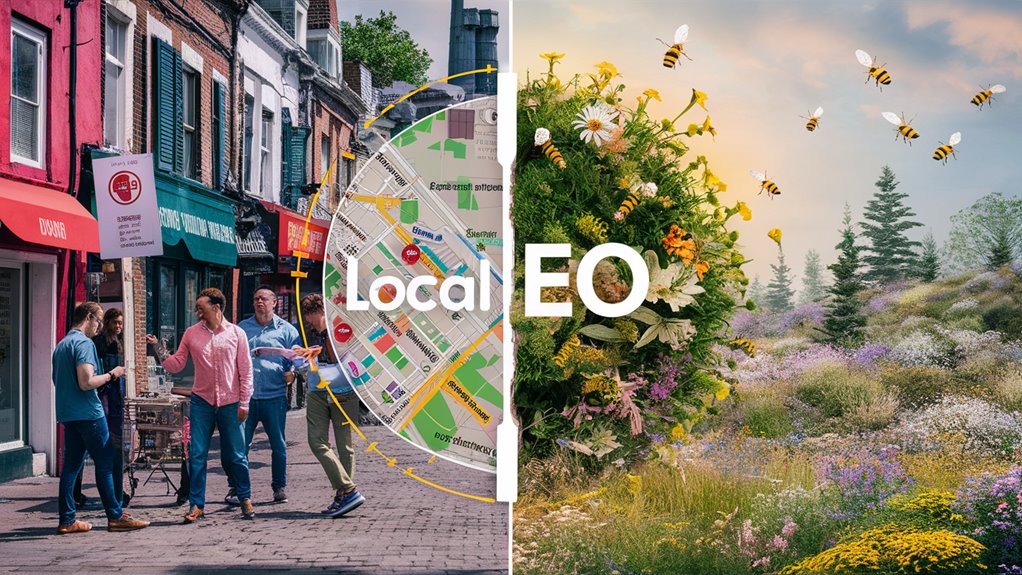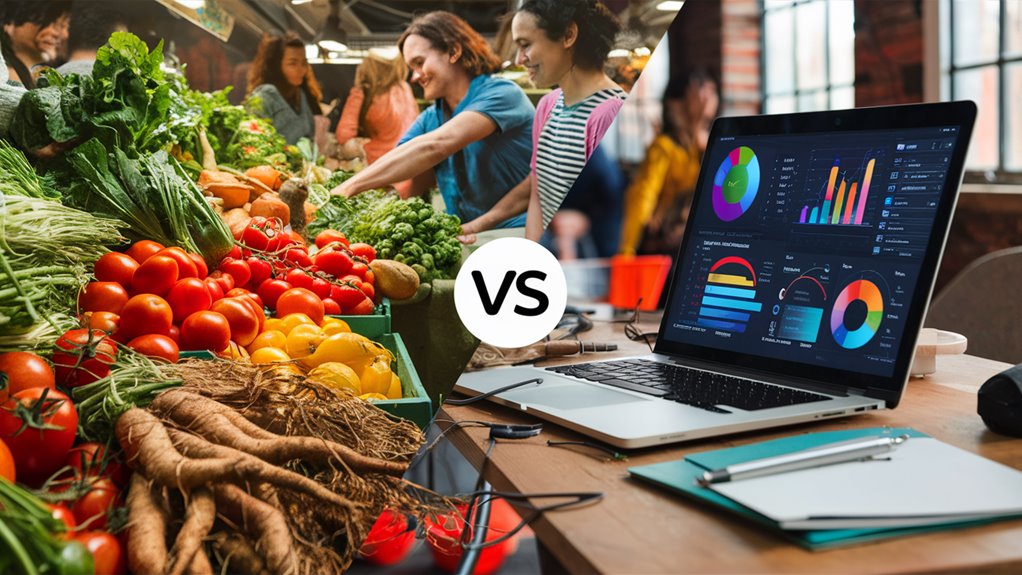Local SEO vs Organic: What’s the Difference
It’s easy to confuse local and organic strategies, but they serve different purposes. Local SEO zeroes in on attracting customers in your immediate area, while organic SEO aims for broader visibility across the web.
Each approach employs unique tactics tailored to their objectives, yet both are essential for a well-rounded digital presence.
So, how do you decide which strategy to prioritize, and can they work together effectively? The answers might surprise you as you explore the nuances of these two powerful tools.
Understanding Local SEO
When you’re running a local business, understanding Local SEO is crucial for attracting nearby customers. This niche strategy focuses on optimizing your online presence to appear in Google’s local search results.
By targeting users who perform “near me” searches, you can boost your chances of ranking in Google’s local 3-pack, which elevates your visibility for localized queries.
A smart fixed price SEO strategy can make this process easier by focusing on key components like optimizing your Google Business Profile and ensuring your Name, Address, and Phone (NAP) information is accurate.
By leveraging local SEO, you can increase foot traffic to your business—about 50% of searchers visit local businesses within 24 hours of doing a local search.
By maintaining consistent citations across various online platforms, you can seriously boost your local search visibility.
It’s important to note that while local SEO focuses on a specific area, organic SEO targets broader searches. but effective local SEO improves community trust and loyalty, making it essential for small businesses with physical locations.
Understanding Organic SEO
In today’s digital landscape, mastering Organic SEO is fundamental for any business looking to improve its online presence. Organic SEO is the process of enhancing your website’s visibility in unpaid search engine results pages (SERPs).
By focusing on relevant industry-specific keywords, you can target a broader audience instead of just local terms.
High rankings in organic search are essential since research shows that 75% of searchers don’t click past the first page of results.
To improve your search engine rankings, you need to pay attention to content quality, keyword relevance, and backlinks.
These factors help establish your website’s authority and expertise, which are critical for gaining trust from both search engines and users.
When you focus on creating high-quality content that showcases your knowledge, you not only improve your organic SEO performance but also boost brand awareness.
by demonstrating expertise and building authority, you can attract qualified leads. Also by implementing locally relevant content into your strategy can improve engagement with nearby customers.
Key Differences

Understanding the key differences between local and organic SEO is a must for properly tailoring your digital marketing strategy.
Local SEO focuses on reaching customers in specific geographic areas, helping your visibility in local search results like Google’s Local Pack.
In contrast, Organic SEO aims for a broader audience without a location-specific emphasis, improving your search engine rankings across standard SERPs.
For local SEO, optimizing your Google My Business (GMB) profile is one of the first steps you should take. This helps potential customers find your business easily. You should make it standard practice to keep your GMB fresh and updated.
On the flip side, organic SEO relies more on website content and backlinks to drive traffic. While local SEO emphasizes localized content relevant to a community, Organic SEO prioritizes general content that appeals to a wider range of interests.
When measuring success, local SEO often looks at local visibility and foot traffic, while Organic SEO considers overall site traffic and rankings on search engines. Implementing a solid local SEO strategy can seriously boost your business’s visibility.
Local SEO Best Practices
To boost your local SEO, start by claiming and optimizing your Google Business Profile as mentioned above – which is vital for visibility in local search results and attracting nearby customers.
Make sure that you include accurate information like your location, hours, and services. Keeping your local listings updated helps build trust with potential customers.
Focus on keyword research to identify region-specific terms. This can help you effectively target local customers and improve your search rankings.
Remember, mobile optimization is fundamental, as 76% of local searches lead to an in-store visit within a day. Check your site is easily accessible on/from mobile devices.
Also make it standard practice to use high-quality images in your content, this can massively improve your online visibility. Listings with professional photos receive 42% more clicks, so invest in good visuals to engage potential customers better.
Ultimately, following these local SEO best practices will help your business stand out. By taking care of your Google Business Profile, optimizing for mobile, conducting keyword research, and using quality images, you’ll improve your chances of showing up in local search results and attracting more customers.
Furthermore, leveraging local citations can further boost your search rankings and credibility.
Organic SEO Best Practices
Mastering organic SEO best practices can greatly improve your website’s visibility and drive more traffic. Start by conducting thorough keyword research to find industry-specific terms that potential customers are searching for. This guarantees your content aligns with user intent, which search engines prioritize.
Once you have your keywords, integrate them naturally into your content, including title tags, meta descriptions, and headers.
You should then focus on website optimization. Improve your page speed, which is a ranking factor for Google. Faster loading times lead to better user experience and lower bounce rates, keeping visitors engaged on your site.
If you have a slow loading site, many people wont wait around for it to load, and click the back button. A cool free plugin you can use is this one from NitroPack.
Use internal linking to guide users through your content. This creates longer browsing sessions and helps distribute page authority, thereby improving your site’s local SEO relevance and boosting search visibility.
Regularly analyze performance metrics using tools like Google Analytics to assess traffic sources and user behavior.
Understanding how users interact with your site allows for ongoing adjustments to your SEO strategy.
When to Use Each
Deciding when to use local SEO versus organic SEO can make a big difference in your marketing strategy. If you run a brick-and-mortar business or a service provider that depends on foot traffic, local SEO is the one. This strategy helps you target local customers in specific geographic regions, improving your visibility in local search queries.
For instance, if you own a coffee shop, local SEO guarantees people nearby find you when searching for coffee.
On the other hand, organic SEO is the way to go when businesses need to increase their overall online visibility. This approach is ideal for ecommerce platforms and those targeting a broader, non-location-specific audience.
If you’re looking to boost brand awareness and reach more people, organic SEO focuses on general visibility across search engines, making it your best bet.
for businesses offering exclusive local products or services, using local SEO helps you attract relevant local customers actively searching for those offerings. Implementing effective local SEO strategies can maximise your online presence in your target area.
Integrating Both Strategies

Integrating both local and organic SEO strategies can indeed boost your business’s online presence. You can reach customers who are ready to visit your physical location while also engaging those looking for information online.
You should also leverage positive online reviews which can support your local search rankings, making it easier for potential customers to find your business.
Combined SEO Benefits
When you combine local and organic SEO strategies, you can greatly boost your business’s visibility in both local and broader search results. This approach maximizes your reach and engagement with potential customers.
Local SEO, focusing on local keywords and optimizing your Google Business Profile, often leads to higher conversion rates. In fact, 76% of searchers visit businesses within 24 hours of conducting local searches.
On the other hand, organic SEO increases brand awareness over time through effective content creation and backlink building.
Integrating these two strategies creates a thorough search engine optimization plan that meets diverse customer needs. A well-structured website improves your online visibility and helps guide visitors effectively.
By addressing both local and organic SEO, you can build brand authority and trust among consumers. With high rankings in both areas, your business gains credibility, making it more appealing.
Regularly analyzing performance across local and organic channels allows you to adjust your marketing strategies based on user behavior.
This ongoing process helps boost your overall online presence and guarantees you’re meeting your audience’s expectations, and combining local and organic SEO, you are truly setting your business up for success.
Target Audience Overlap
Many businesses find that their target audiences overlap between local and organic SEO efforts. Local SEO focuses on attracting customers from specific geographic areas, while organic SEO aims for a broader audience.
However, when you combine both strategies, you can reach a wider range of potential customers.
For example, local searches are largely for driving foot traffic to your physical store, or getting your local service based business in front of people. As mentioned 76% of people searching locally will visit a store within 24 hours. This highlights the power of local SEO for immediate engagement.
At the same time, organic SEO amplifies your brand visibility and online engagement, attracting customers from outside your area. Using region-specific keywords in local SEO complements your broader keyword strategies in organic SEO.
This way, you engage both local customers and those interested in your offerings from afar. By integrating these strategies, you can improve your conversion rates, as local searches often yield more qualified leads ready to make a purchase.
Ultimately, understanding the overlap in your target audience can heighten your marketing efforts, ensuring you get the most out of both local and organic SEO strategies.
Implementation Best Practices
To combine local and organic SEO strategies, focus on optimizing your Google Business Profile while improving your website content with industry-specific keywords.
Start by making NAP consistency (Name, address and phone number) are the same across all of the local directories you are listed in. This helps search engines verify your business’s legitimacy.
Be sure to create high-quality content that attracts both local customers and a broader audience. Use localized content, like blog posts about community events, to engage your local market while boosting your organic search rankings.
Regularly monitor performance metrics from both your local and organic SEO efforts. This allows you to adjust your strategies for maximum visibility.
Incorporate customer feedback into your content to build trustworthiness. Combining local SEO strategy with strong organic content can support your overall search engine optimization (SEO) results.
Conclusion
To sum it up, local SEO and organic SEO serve different purposes. Local SEO helps businesses connect with nearby customers, while organic SEO aims for a wider audience online.
You can use both approaches to maximize visibility and attract more customers. By following best practices for each, you can strengthen and improve your business’s reach and engagement.

